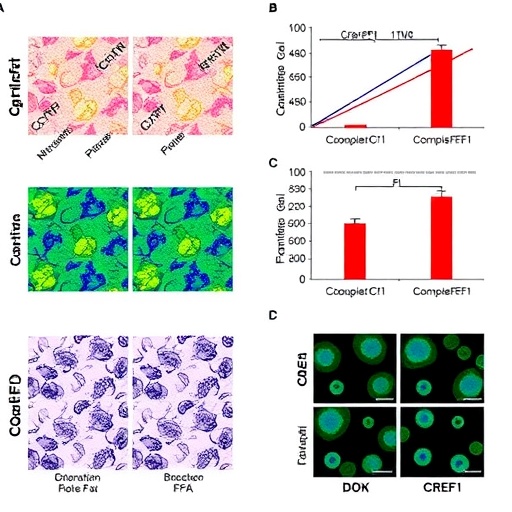In the relentless quest to unravel the mysteries of cellular longevity and resilience, researchers at the University of Cologne and Heinrich Heine University Düsseldorf have made a groundbreaking discovery that could revolutionize our understanding of proteostasis and aging. Their recent study published in Molecular Cell introduces a novel form of ubiquitin—termed C-terminally extended ubiquitin (CxUb)—that plays a pivotal role in enhancing cellular defense mechanisms against stress and promoting healthy aging.
Ubiquitin, a small yet highly influential protein, is central to the regulation of protein quality within eukaryotic cells. By tagging damaged or improperly assembled proteins for degradation, ubiquitin maintains proteostasis, a crucial homeostatic balance that preserves cellular function and viability. Disruptions in this proteolytic system are implicated in numerous pathological conditions, including cancer and neurodegenerative disorders. Traditional therapeutic approaches that target ubiquitin or its associated degradation pathways have demonstrated efficacy, particularly in oncology. However, these interventions often induce considerable side effects such as neuropathy, cardiovascular complications, and systemic fatigue, thereby underscoring the urgent need for more refined strategies.
The collaborative international team embarked on a detailed exploration of stress responses in model organisms, focusing on Saccharomyces cerevisiae (baker’s yeast) and Caenorhabditis elegans, a nematode extensively utilized in aging research. Intriguingly, they identified the presence of a ubiquitin precursor with a distinctive C-terminal extension, dubbed CxUb. Contrary to its prior classification as an inert molecular species, CxUb was unveiled as an active agent that orchestrates enhanced proteostatic control particularly under stressful cellular conditions.
Diving deeper into the molecular mechanisms, the investigators demonstrated that upon environmental stressors, CxUb transitions from a precursor state into a functionally active modifier. This active form preferentially conjugates to aberrant proteins and defective mitochondria, amplifying ubiquitin tagging and thus accelerating their clearance. This selective escalation in proteolytic signaling enables cells to circumvent the deleterious accumulation of toxic protein aggregates, a hallmark of aging and proteostasis-associated diseases, without disrupting the essential housekeeping roles of standard ubiquitin.
The specificity of CxUb’s functionality marks a notable advancement in cellular quality control pathways. Unlike canonical ubiquitin, which maintains baseline proteostasis, CxUb’s inducible activity provides a robust, yet finely tuned, adaptive response. This dynamic allows organisms to preserve cellular integrity and promote longevity even amidst persistent stress. Such a mechanism offers unprecedented selectivity, minimizing collateral damage to healthy cellular components and mitigating the adverse effects associated with broad-spectrum ubiquitin-targeting therapeutics.
Senior author Professor Andreas Reichert emphasized the biological elegance of this system, highlighting how CxUb’s swift and simple defensive deployment targets the root causes of cellular distress, notably protein aggregates and mitochondrial dysfunctions. These pathological features are well-known drivers of cellular senescence and organismal decline. The researchers posit that the conservation of CxUb across all eukaryotic life forms suggests a similar protective role in humans, laying the foundation for translational applications that could harness this molecular pathway to combat age-related diseases.
Principal Investigator Dr. Mafalda Escobar-Henriques underscored the therapeutic potential harbored in their discovery: “Our findings open avenues to develop interventions that activate or mimic CxUb function, offering safer and more effective treatments for cancers and neurodegenerative disorders by enhancing proteostatic capabilities with reduced side effects.” By fostering selective clearance of harmful proteins, such therapies could revolutionize disease management paradigms that hinge on proteostasis modulation.
Integral to this landmark study was the application of cutting-edge methodologies including advanced proteomics, high-resolution microscopy, and targeted biochemical assays. These technological innovations enabled the researchers to dissect the nuanced roles of ubiquitin variants with unparalleled precision. The facilities at the CECAD Cluster of Excellence on Aging Research and the Center for Molecular Medicine Cologne (CMMC) were instrumental in facilitating these experiments, demonstrating the power of collaborative infrastructures in driving scientific breakthroughs.
This work exemplifies the fruitful synergy between the research groups at the Universities of Cologne and Düsseldorf, combining expertise in genetics, molecular biology, and aging research. Supported robustly by the German Research Foundation (DFG) through multiple Collaborative Research Centres, this collective endeavor signifies a milestone in decoding how cells harness specialized ubiquitin forms to maintain internal equilibrium in the face of environmental challenges.
Considering that CxUb-mediated stress resolution was effective against every stressor tested in yeast models, the researchers are optimistic about extrapolating these findings to mammalian systems. Future studies are planned to assess the implications of CxUb in human cellular models and animal disease paradigms, focusing particularly on its role in ameliorating proteostasis defects implicated in cancer and neurodegenerative diseases like Alzheimer’s and Parkinson’s.
This discovery challenges the longstanding assumption that ubiquitin precursors with C-terminal extensions are inactive byproducts, positioning CxUb as a vital component of the proteostasis network. It redefines our conceptual framework of ubiquitin biology and underscores the versatility of molecular adaptations that cells employ to ensure survival and functional longevity.
The pioneering identification of CxUb not only enriches fundamental biological understanding but also heralds a new frontier in therapeutic design. By selectively enhancing the degradation of pathogenic protein species, this molecular strategy may pave the way for interventions that prolong healthspan and ameliorate diseases intrinsically linked to aging.
With aging populations worldwide and the rising burden of age-associated diseases, the implications of this research resonate far beyond basic science. Harnessing the unique capabilities of CxUb could catalyze a paradigm shift from symptom management to etiological treatment in chronic conditions that degrade life quality globally.
In sum, the elucidation of the ubiquitin precursor with C-terminal extension as a linchpin in proteostasis maintenance and longevity represents a seminal advancement with profound clinical and biological ramifications. This study illuminates an elegant, evolutionarily conserved molecular defense that could shape the future of medicine.
Subject of Research: Cells
Article Title: Ubiquitin precursor with C-terminal extension promotes proteostasis and longevity
News Publication Date: 23-Sep-2025
Web References: 10.1016/j.molcel.2025.08.032
References: Molecular Cell, 2025, Escobar-Henriques M. et al.
Keywords: ubiquitin, C-terminal extension, proteostasis, aging, cellular stress response, protein degradation, longevity, neurodegenerative diseases, cancer therapy, molecular biology, proteomics, mitochondrial quality control
Tags: breakthroughs in cellular longevity researchCaenorhabditis elegans in lifespan studieseukaryotic cell protein regulationhealthy aging mechanismsimplications of ubiquitin in neurodegenerative disordersinnovative strategies in cancer therapymodel organisms in biological studiespotential side effects of ubiquitin-targeted therapiesproteostasis and cellular functionSaccharomyces cerevisiae research findingsstress resistance in aging researchubiquitin precursor C-terminally extended ubiquitin





